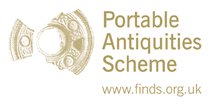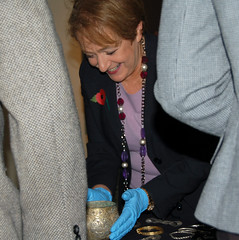Server check!
You are on the training database
Annual report (Treasure and PAS) 2007
Get the entire report in one document.
The Staffordshire Hoard, the most remarkable archaeological discovery for a generation, goes on temporary public display at the British Museum today, to coincide with the launch of the Portable Antiquities and Treasure Annual Report 2007; both events are being launched by Margaret Hodge, Culture Minister. Highlights of the hoard will be displayed, fresh from the earth, from 3rd November until the New Year in gallery 37, near to the famous Sutton Hoo Anglo-Saxon Treasure.
The Staffordshire Hoard is to be valued by an independent Treasure Valuation Committee by the end of November. Once completed a fundraising campaign will be undertaken to secure the hoard.
Culture Minister, Margaret Hodge; The British Museum; the Museums, Libraries and Archives Council (MLA); Regional Minister, Ian Austin and West Midland's local councils are united in their commitment to ensure that the Staffordshire Hoard has a permanent home in the West Midlands region. Highlights of the hoard will travel to the Potteries Museum in early 2010.
The Staffordshire Hoard is one of over 400,000 archaeological finds recorded by the Portable Antiquities Scheme (PAS) or reported Treasure since 1997 (when legislation regarding the reporting of archaeological finds was last enacted). The scheme is managed by the British Museum on behalf of the Museums Libraries and Archives Council (MLA), funded through the Renaissance in the Regions programme.
The report announces that 747 cases of Treasure were reported in 2007 and a further 66,311 non-Treasure finds were recorded with the PAS on a voluntary basis, adding significantly to our understanding of the past. Without the PAS there would be no mechanism to deal effectively with finds found by the public and ensure the knowledge about them is disseminated for the benefit of all.
The PAS plays an increasingly important role in the operation of the Treasure Act. Since 2003, when the PAS was extended to the whole of England and Wales, there has been an average increase of 194% in the reporting of Treasure, to the benefit of museums across the country. Thanks to funding from sources such as the HLF, Art Fund, MLA/V&A Purchase Fund and Headley Trust, 303 finds reported Treasure have been acquired by museums. It is also the case that in 55 of these cases, one or more parties has waived their rights to a reward; up from 44 in 2006, and 25 in 2005.
Culture Minister Margaret Hodge said:
"The discovery of the enormous Staffordshire Hoard is incredibly significant for the understanding of our Saxon heritage. It also highlights the importance of the Portable Antiquities Scheme and the Treasure Act for ensuring that significant archaeological finds are properly reported and assessed, enriching our knowledge and understanding of the past. It is testament to the Scheme that the number of finds reported has increased year on year since the Act became Law, and significantly so since the Portable Antiquities Scheme was extended across the whole of England and Wales."
Neil MacGregor, Director, British Museum said:
"The discovery and reporting of this find has been a wonderful example of co-operation by all parties concerned. From the beginning of the process the partners all agreed that this great find should be acquired by the West Midlands, it is excellent news that this is now going to happen. This is exactly what a national partnership should be. I am delighted that the hoard can be seen temporarily at the British Museum by a wide number of UK and international visitors. The story of the find demonstrates the PAS working at its best, with the British Museum leading on the academic and research side and Birmingham and Stoke leading on the acquisition. The continuing funding of PAS was secured just over a year ago thanks to unprecendented cross party support. As this report is placed before Parliament we hope that it will secure funding for this essential resource in the future."
Roy Clare, CEO, Museums, Libraries & Archives Council said:
"The Portable Antiquities Scheme is a vital component of the MLA's "Renaissance in the Regions" programme to promote excellence in England's regional museums. We are delighted to be working closely with the British Museum and we are committed to the future success of the PAS at the heart of Renaissance. In particular, we recognise that finds from all over the country make an exciting and vivid complementary connection with existing collections. The public are readily engaged in the stories and all ages relish the significance for identity and for local places. People have responded with great enthusiasm to the recent exceptional discoveries; there have been long queues to view a selection of pieces in Birmingham and a positive start has already been made on raising funds to purchase the hoard from the Crown and later to interpret the items in their proper context in the West Midlands. The PAS has had another highly successful year; the MLA congratulates the many people who make it work so well."
Finds in the report
The Staffordshire Hoard will feature in the Portable Antiquities & Treasure Annual Report 2009. The current report outlines some of the finds recorded in 2007 including:
Cat. no. 101) Roman copper-alloy figurine of Cautopates. Date: c. AD 43-c.410. Found by Chris Hall at Newton Kyme cum Toulson, North Yorkshire, and recorded by Amy Copper (South & West Yorkshire FLO). Cautoplates was one of the attendants of the Roman God Mithras, whose Cult (Mithraism) was popular with Roman soldiers stationed in Britain. Mithras' attendants, Cautes and Cautopates, represented opposing attributes of light and dark, or life and death. Despite the popularity of Mithraism very few metallic votive items and this figurine remains unparalleled.
Cat. no. 135) Roman gold lamella (sheet). Dates: c. AD 200-c.400. Found by David Livingstone in South Oxfordshire and reported to Fi Hitchcock (then Treasure Registrar). A Roman amulet with 16 lines of incised text, including 'magical' characters and an inscription in Greek to the 'holy names' to protect a woman called Fabia, the daughter of Terentia. It is apparently a charm to ensure safe childbirth. When found the object was tightly rolled, and is thought to have been a votive deposit. This is the third such amulet found in Britain, though lamella fragments are also known, and provides an insight to Roman religion in the third and fourth centuries. Acquired by the British Museum.
Cat. no. 217) Viking hoard. Date: deposited in c.AD 928. Found by Andrew and David Whelan in the Vale of York, North Yorkshire, and reported to Amy Cooper (South & West Yorkshire FLO). A Carolingian silver-gilt vessel containing gold and silver objects and 617 silver coins; some objects were found outside the cup. The cup is decorated with six roundels containing running animals in front of a tree or bush; apparently a hunting scene and probably represents Viking loot from a church or monastery in the northern Frankish Empire in the 9th century. The coins are a mix of Anglo-Saxon, Anglo-Scandinavian, Islamic and Carolingian types, and they allow an unusually close date for the deposition of the hoard. Acquired jointly by the British Museum and York Museums Trust.
Cat. no. 285) Medieval silver piedfort. Date: mid 1350s. Found by Mark Stonard at West Clandon, Surrey, and recorded by David Williams (Surrey FLO). It is uncertain what piedforts are, but it has been suggested they are pattern coins, guides for mint workers, or - more likely - reckoning counters for officials. This one, modelled on a coin struck in the name of Edward III as Duke of Aquitaine (1325-62), is the first to be reported under the Treasure Act, and is the third known. The British Museum has acquired.
Cat. no. 414) Post-Medieval lead figurine of Tom Molineaux. Date: c.1800-25. Found by Dorothy Hewison at Ryde, Isle of Wight, and recorded by Frank Basford (Isle of Wight FLO). Tom Molineaux (1784-1818) was born a slave on a plantation in Virginia, USA and boxed against fellow slaves whilst plantation owners wagered on the contests. After winning one of these contests his owner, Algernon Molineaux, gave him his freedom and $500. By 1909 Molineaux was boxing in New York and subsequently fought in England, boxing against English champion Tom Cribb in 1810 and 1811, and after which he became a celebrity.
Notes to Editors:
1. All finders of gold and silver objects, and groups of coins from the same finds, over 300 years old, have a legal obligation to report such items under the Treasure Act 1996. Prehistoric base-metal assemblages found after 1 January 2003 also qualify as Treasure. Treasure finds must be reported by law to the local coroner, which is normally done through the finders local PAS Finds Liaison Officer. The Treasure Process is administered by the British Museum. More information is available on www.culture.gov.uk or www.finds.org.uk
2. The Portable Antiquities Scheme (PAS) is a voluntary scheme managed by the British Museum on behalf of the Museums Libraries and Archives Council (MLA) to record archaeological objects (not necessarily 'Treasure') found by members of the public in England and Wales. Every year many thousands of objects are discovered, many of these by metal-detector users, but also by people whilst out walking, gardening or going about their daily work. Such discoveries offer an important source for understanding our past. More information can be found on www.finds.org.uk
3. Renaissance is the MLA's ground-breaking programme to transform England's regional museums. Central government funding is enabling regional museums across the country to raise their standards and deliver real results in support of education, learning, community development and economic regeneration. The programme has received £300million since 2002, helping to make museums great centres of life and learning, which people want to visit.
4. Leading strategically, the MLA promotes best practice in museums, libraries and archives, to inspire innovative, integrated and sustainable services for all. Visit www.mla.gov.uk




